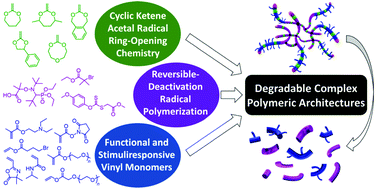Reversible-deactivation radical polymerization of cyclic ketene acetals
Abstract
While synthetic polymers have found widespread application in personal and consumer care, and agrochemical and biomedical applications, there remains a constant drive to increase the level of sophistication within polymeric systems to further improve their utility. Dating back to 1993, reversible-deactivation radical polymerization (RDRP) techniques have been commonly adopted to increase complexity. In the intervening 27 years we have seen tremendous progress in the preparation of remarkable polymeric architectures, possessing exotic morphologies, stimuliresponsiveness and diverse functionality. However, their post-use accumulation in the natural world and human body is a topic of growing concern. Therefore, the development of degradable polymeric structures is an important objective facing polymer chemists. Imparting degradability, in the form of main-chain ester bonds, into free radical chain-growth polymers can be achieved via radical ring-opening polymerization (rROP) of cyclic ketene acetals (CKAs) in the presence of conventional vinyl monomers. While this method has been well understood since 1982, more recent efforts have pursued the incorporation of CKA monomers within a wider range of polymeric materials. This review discusses the exciting progress made combining RDRP techniques with rROP of CKAs. Research at the interface of these two fields presents an extremely attractive route towards degradable complex polymeric architectures.



 Please wait while we load your content...
Please wait while we load your content...